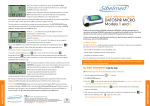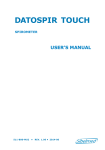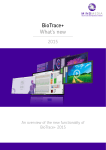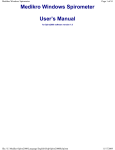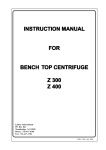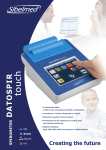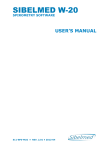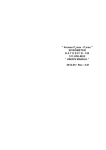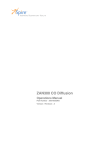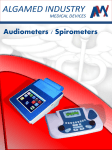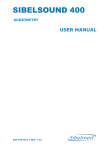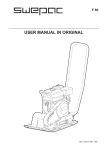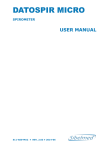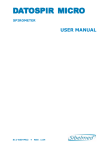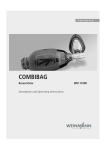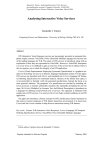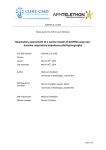Download SPIROMETER DATOSPIR 600
Transcript
SPIROMETER DATOSPIR 600 USER’S MANUAL 511-900-MU2 • Rev 2.02 • 2013-10 Spirometer DATOSPIR 600 3 1. INSTRUCTIONS FOR USE AND INSTALLATION 1.1.INTRODUCTION 1.2.PREVIEW 1.3. DISTRIBUTION OF CONTROLS, INDICATORS AND CONNECTORS 1.3.1. FRONT PANEL 1.3.2. RIGHT AND LEFT SIDE 1.3.3. BACK PANEL 1.3.4. STANDARD ACCESSORIES 1.3.5. OPTIONAL ACCESSORIES (according to model) 1.4. INSTALLATION AND SETUP 1.4.1.INSTALLATION 1.5.PULSIOXIMETER 1.6.CALIBRATION 1.7. UPDATING THE DEVICE SOFTWARE 1.8. TECHNICAL SUPPORT 2. TECHNICAL SPECIFICATIONS 2.1. SOFTWARE COMPATIBILITY 2.2. TYPES OF TESTS, FUNCTIONS AND SPIROMETRIC PARAMETERS 2.3. MEASUREMENT SYSTEM 2.4. ANALYSIS CRITERIA 2.5. ELECTRONIC WEATHER STATION 2.6. MAXIMA PRESSURE MODULE 2.7. PULSEOXIMETER MODULE 2.8. GENERAL DATA 2.9.SIMBOLOGY 3. FUNCTIONING PRINCIPLES 4. SPIROMETRY TECHNIQUE 5. PRESERVATION, PREVENTIVE AND CORRECTIVE MAINTENANCE 6. MODIFICATIONS ANNEX 1. ELECTROMAGNETIC COMPATIBILITY 511-900-MU2 • REV. 2.02 Contents CONTENTS Revised Date: 2013-10 Revised Date: 2013-10 Antoni Picó Technical Manager Carlos Recio Sales Manager 0318 IN ACCORDANCE WITH 93/42/EEC Medical Devices Directive II a Class SIBEL S.A. Rosselló 500, 08026 Barcelona - Spain Ventas Nacionales: Tel. 93 436 00 08 - email: [email protected] Ventas Internacionales / International Sales: Tel. +34 93 436 00 07 - email: [email protected] Servicio Técnico / Technical service: Tel. +34 93 433 54 50 - email: [email protected] Fax : +34 93 436 16 11 - Web: www.sibelmed.com Spirometer DATOSPIR 600 5 Safety SAFETY SPECIAL PRECAUTIONS The spirometer DATOSPIR-600 has been designed to have the maximum safety. All the operation instructions must be read before starting the DATOSPIR-600. Otherwise, injures to the user or the patient and damage to the device and/or accessories might occur. INTENDED USE The spirometer measures and calculates a long list of human respiratory function parameters. The spirometer is not designed to be used in open air conditions, or under any other conditions or energy supply not foreseen in this manual. The spirometer is not intended to be used in moving transport vehicles. It is adviseble to use the device in an acoustic environment enough silent to allow the patient make the manouvers correctly and hear the acoustic warnings. The device must be located in a safety position. This avoids it falls down and consequently any failure to the device or damage to patient and/or user. USER PROFILE The spirometer is designed to be used by medical staff only, being supervised by a physician. Specific training in spirometry is recommended. Bronchoconstriction test must be performed and supervised by qualified staff. User must be familiarized with the functioning of the device before beginning to perform tests with patients. All necessary information can be found in the user’s manual. 511-900-MU2 • REV. 2.02 Safety Spirometer DATOSPIR 600 6 For more information, consult SIBEL S.A or your regular distributor. PATIENT’S EFFECTS IN THE SPIROMETER USAGE Spirometry tests require the patient’s collaboration, the patient must perform a complete forced expiration to be able to get meaningful FVC values. The doctor should assess the patient’s capacity to perform the spirometry tests. Special precaution must be taken with children, elderly people and disabled people. LIMITATIONS IN USE. CONTRAINDICATIONS An spirometry test results analysis is not enough for itself to carry out an accurate diagnosis on the patient’s clinical condition, therefore it must be completed with the clinical history and those tests the doctor considers necessary. The tests interpretation and the derived treatments must be performed by a doctor. The patient’s symptoms before the execution of any spirometry test must be considered by health care personnel. Health care personnel is responsible of the acceptability of a test. The spirometer must not be used when results validity might be probably compromised due to external factors. Take care NOT to place the equipment where it could be splashed by water or other liquids or cover it with objects that prevent air from circulating around it while it is running. The device should NOT be used stacked or adjacent to other equipment. The equipment must be stored and used within the temperature, pressure and humidity ranges specified in this manual. 511-900-MU2 • REV. 2.02 Spirometer DATOSPIR 600 7 DO NOT alter the integrity of the system earth connection. The protection against electrical hazards is provided by the chassis connection to the safety earth. The safety earth connection is only effective when the power supply cable of three wires provided with the device is plugged to an electrical socket properly connected to earth. DO NOT remove the device or accessories cover. Servicing and repair of the apparatus must only be carried out by trained personnel. Contact with the voltage inside the system can cause serious injury. DO NOT use damaged transducers, accessories or cables. DO NOT submerge the device parts in any liquid. IT CAN RESULT IN ELECTRICAL DISCHARGE. DO NOT use multiple mains sockets, unless they comply with EN-60601-1. They can degrade electrical safety. ELECTRICAL DISCHARGE To ensure vital safety features under the EN 60601.1 standard, only equipment compliant with the electrical safety standards in force may be connected to this device. To connect DATOSPIR 600 to a non-medical device with ground conductor, you must install an additional ground conductor to the non medical device. EXPLOSION RISKS DO NOT uses the device in presence of anaesthetics or flammable gases. IT CAN RESULT IN EXPLOSION. RISKS OF CONTAMINATION Fleisch and Turbine Transducers: To avoid risks of contamination or crossed infection, the turbine and the Fleisch neumotacho511-900-MU2 • REV. 2.02 Safety ELECTRICAL RISKS Safety Spirometer DATOSPIR 600 8 meter must be disinfected following this manual’s instructions and its mouthpieces must not be reutilized. Disposable Transducers: It must not be reutilized, each new one must be used for each new patient. The use of mouthpieces or any other consumibles of the product manufactured with improper materials that can compromise their biocompatibility must be avoided. RISK OF INTERFERENCE This is an electronic product, so high frequency emissions can interfere with the correct use. For this reason, the products which can generate interferences (radios, cellular phones, etc.) should be kept apart. The portable or mobile radiofrequency devices can affect the normal functioning of the electronic medical devices. This is a medical electronic device and as such it needs special precautions regarding the electromagnetic compatibility (EMC) and it should be installed and setup according to the EMC information attached (See Appendix 1. ELECTROMAGNETIC COMPATIBILITY). The use of transducers, accessories and cables different to the ones specified here, except the transducers and cables sold by the manufacturer as spare parts, could adversely affect patient safety, cause a malfunction of the equipment and/or produce an increase of the emissions or a decrease in the device immunity. REMOVAL OF WASTE FROM ELECTRICAL AND ELECTRONIC APPLIANCES BY DOMESTIC USERS IN THE EUROPEAN UNION This symbol on the product indicates that you cannot dispose of the product with domestic waste. 511-900-MU2 • REV. 2.02 Spirometer DATOSPIR 600 9 511-900-MU2 • REV. 2.02 Safety However, any removal of this type of waste is the responsibility of the user and must be taken to a designated collection point for the recycling of electrical and electronic appliances. The separate recycling and collection of this waste at the time of removal will help preserve natural resources and ensure that recycling protects your health and the environment. Should you require further information on the places where you can leave this waste for recycling, contact the local authorities in your town or city, the domestic waste management service or the distributor who sold you the product. Instructions Spirometer DATOSPIR 600 10 1. INSTRUCTIONS FOR USE AND INSTALLATION 1.1. INTRODUCTION The spirometer DATOSPIR-600 is a compact device held in a platform type C. It has different types of transducers (Fleisch, turbine and /or disposable). It can include a module for measuring the Inspiratory and Espiratory Maximal Pressures (MIPMEP or PIM-PEM), and other module for Pulseoximetry measurements (SpO2). The system of data acquisition and transfer is controlled by a microprocessor. In the PC platform a powerful software is installed, which controls, analyses, stores and displays the spirometric signals. It works under Microsoft Windows. It enables, among other functions: The management of different Data Bases The performance of FVC, VC, MVV and Postbronchodilation tests The graphic presentation in F/V and V/T modes The selection of different Reference Parameters The selection of different diagnosis types The printing of different reports The presentation of graphics for motivated tests with children The spirometer DATOSPIR-600 has been developed by the department of R+D of SIBEL, S.A. in collaboration with Laboratory of Pulmonar Function in the Hospital de la Santa Creu i Sant Pau of Barcelona according to the Quality Manual of Sibel S.A. and in concordance with the quality standards EN 46001 and ISO 9001, as well as the European Medical Device Directive 93/42/EEC. According to this directive, it is considered as a product of class IIa. It also meets the norms of Electric Safety of the product EN60601.1, IEC 601.1, and the Electromagnetic Compatibility Standards EN 60601.1.2. View annex Electromagnetic Compatibility. 511-900-MU2 • REV. 2.02 Spirometer DATOSPIR 600 11 This User´s Manual is oriented to all the models and options which can form the spirometer DATOSPIR-600. For each case, only the options or functions for each model will be applied. The series of spirometer DATOSPIR-600 consists of three different models, depending on the options included: DATOSPIR-600 F DATOSPIR-600 T DATOSPIR-600 D The enclosed table shows the basic characteristics for each model, standard (X) and other optional parts or functions (O). A model can be transformed into a superior one, by adding the corresponding parts. In that case, consult the Commercial Department of Sibel, S.A., or your distributor. OPTIONS DATOSPIR-600 F T D Transducer FLEISCH..................................... X O O Transducer TURBINA ...................................O X O DESECHABLE Transducer..............................O O X FVC, VC and MVV tests in PRE and POSTbronchodilation mode ......................... X X X Bronchoconstriction Test ............................. X X X Graphics superposition ................................ X X X Auto-check program .................................... X X X Graphic incentive for children . ................... X X X Setup program ............................................ X X X Data Bases................................................... X X X Printing with external printer....................... X X X Transfer via INTERNET through PC of Patients Tests . ........................................ X X X Device check-up....................................... X X X Software update ...................................... X X X Calibration Program .................................... X X X Export of tests to other systems . ................ X X X Module of electronic weather station . ......... O O O Module of SpO2............................................ OOO 511-900-MU2 • REV. 2.02 Instructions 1.2. PREVIEW Instructions Spirometer DATOSPIR 600 12 Module of PIM-PEM...................................... O O O This product is manufactured under strict quality controls. Nevertheless, accidents may 1-3 happen in the transport or storage, so it is convenient to make a status check before installing it, as well as of its accessories 511-900-MU2 • REV. 2.02 Spirometer DATOSPIR 600 13 USER’S MANUAL 511-900-MU2 • Rev 2.02 • 2013-10 511-900-MU2 • REV. 2.02 Instructions SPIROMETER DATOSPIR 600 14 Instructions Spirometer DATOSPIR 600 511-900-MU2 • REV. 2.02 Spirometer DATOSPIR 600 15 SIBEL S.A. is responsible for the safety, reliability and functioning of this device only if: - The place where the device is and the computer where the software is installed meets the requirements related to electrical installation IEC (UNE) for medical devices, as well as the other applicable norms. - The repairs, checks or modifications, in or out the warranty period, are performed by technical staff at SIBEL S.A. - The use of the software and the recommendations of use are made by qualified staff, according to the User’s Manual. 511-900-MU2 • REV. 2.02 Instructions RESPONSABILITY OF THE MANUFACTURER Instructions Spirometer DATOSPIR 600 16 1.3. DISTRIBUTION OF CONTROLS, INDICATORS AND CONNECTORS 1.3.1. FRONT PANNEL No.1 Functioning signal pilot. 1.3.2. RIGHT AND LEFT SIDE No.2 Connection of spirometric transducer No.3 Connection of pulse oximetry sensor SpO2 No.4 Connection of the Maximal Respiratory Pressures transducer MIP-MEP No.5 Board of characteristics 511-900-MU2 • REV. 2.02 Spirometer DATOSPIR 600 17 Instructions 1.3.3. BACK PANNEL No. 6 Serial communications port No. 7 Connection of mains supply No. 8 Additional Earth connection No. 9 Housing for the Electronic Weather Station 511-900-MU2 • REV. 2.02 18 Instructions Spirometer DATOSPIR 600 1.3.4. STANDARD ACCESSORIES No. 10 Disposable mouthpiece No. 11 Nose clip No. 12 User´s Manual No. 13 Mains supply No. 14 Neumotachometer type Fleisch with holder No. 15 Transducer with turbine No. 16 Cable for data interconnection between DATOSPIR 600 and PC No. 17 Disposable transducer 1.3.5. OPTIONAL ACCESSORIES (depending on model) No. 18 Accessories option MIP-MEP No. 19 Accessories option pulse oximetry SpO2 No. 20 Disposable transducer with holder No. 21 Transport bag No. 22 Calibration syringe 511-900-MU2 • REV. 2.02 Spirometer DATOSPIR 600 19 Instructions 1.4. INSTALLATION AND SETUP 1.4.1. INSTALLATION The spirometer DATOSPIR-600 belongs to CLASS IIa, according to the criteria of Medical Products European Directive 93/42/CEE, and according to the type of protection against electrical shock hazard, the norm EN60601.1, the classification for the device is CLASS I type B. The spirometer DATOSPIR-600 works as standard through an external power supply connected to a main electrical supply of 511-900-MU2 • REV. 2.02 Instructions Spirometer DATOSPIR 600 20 200 to 240 V 50/60 Hz with earth connection (under demand of 100 to 130 V 50/60 Hz) The link of data between the device and the computer is optically isolated. The computer connected to the device must meet the requirements of electric safety for this type of devices (IEC950, EN60601, etc.) The maximum power required (including the calefactor of the neumotachometer Fleisch) is under 25 VA. The environment conditions for properly operation are: -Temperature 10º to 40ºC. (The American Thoracic Society recommends 17º to 40ºC) -Humidity lower than 85% (without condensation) -Atmospheric pressure from 525 to 800 mmHg (from 3000 to -400 metres approx.) The power supply cable includes the protection conductor, as the spirometer has to be connected to the ground, like every electromedical device of the CLASS I, according to EN60601.1. Do not place the device close to water or other liquid sources. Do not cover the device with objects which can prevent the air circulation during its functioning. The sequence of operations to setup the DATOSPIR-600 in connection with the PC is the following: 1 Connect the power supply output to the connection no.7 2 Put the power supply switch in position 0 “OFF” 3 Connect the power supply to the mains according to its voltage and frequency, as specified in the power supply, and set the switch in position “I” START (Light on). Then the DATOSPIR 600 will emit a “beep-beep”. NOTE: If you have purchased the pulseoximetry module, the power supply will not have on-off interruptor. It will be only necessary to connect it to the power mains. 4 Connect the transducer to the connector number 2. 511-900-MU2 • REV. 2.02 Spirometer DATOSPIR 600 21 WARNING The disposables transducers are individually pre-calibrated and they have and asociated factor. Therefore, there is no need to carry out any calibration. The factor must be introduced in the software so far the measurement is performed correctly. Before perform any test, the check that the factor is the in the plastic bag and in the screen. The factor can change from one bag to another, but not inside the same. If you purchase a new lot of disposable transducers, remember to check and if necessary, update the transducer factor. If all the indications are fulfilled, the device is ready to be setup. B.- INSTALLATION OF SPIROMETRY SOFTWARE For the Software installation in the PC hard disk, follow the SPIROMETRY SOFTWARE SIBELMED W-20 USER’S MANUAL. 511-900-MU2 • REV. 2.02 Instructions 5 Insert the mouthpiece in the transducer (turbine or fleisch transducer), or o disposable transducer in the disposable transducer handle. Instructions Spirometer DATOSPIR 600 22 1.5.1 PULSIOXIMETRY 1.5.1 SAFETY INTENDED USE This oximetry sensor should be used by a physician or under the supervision of medical staff. The pulse oximeter does NOT require calibration. The pulse oximeter has NO physiological alarms. Pulse oximeter probes do NOT allow temporary immersion. The pulse oximeter waveform is NOT normalizzed. Patient movements or excessive lighting can affect the accuracy of the device. The pulse oximetry module has CE marking and can not reach temperatures> 42 º. The oxygen saturation and heart rate measures must be performed using the sensors manufactured by MEDIAID: POX 050-105S (clip) and POX050-820s (Flexible), which have been validated clinically. Otherwise, there may be significant measurement errors. These pulse oximetry probes have been validated for the M15 module from MEDIAID. The wavelengths used are 660 nm (red) and 910 nm (infrared) and the optical power is about 9.6mW. Consult the instructions for use of the probes, before use. Follow strictly manufacturer’s safety instructions, as well as those specified in this manual. See instructions for use of the sensor to evaluate the toxicity of SpO2 sensor. 511-900-MU2 • REV. 2.02 Spirometer DATOSPIR 600 23 For log term monitoring, is recommended to use flexible or disposable sensors. The adult sensor is intended for use on people over 12 years old. The peadiatric probe is for children between 3 and 12 years. Although, the adults probes can be used on any pediatric patient whose fingertip reaches the finger stop of the sensor and on whom the sensor fits securely. The system can measure pulse and functional oxygen saturation. A functional meter can not be used to evaluate the accuracy of pulse oximeter probe or a pulse oximeter monitor. DEGREE OF PROTECTION AGAINST LIQUIDS Degree of protection against harmful ingress of water. Dripproof IPX1 1.5.2 PULSEOXIMETRY TEST PROCEDURE WARNING Use only the oximetry sensor supplied by the DATOSPIR 110/120 spirometer manufacturer. If you use nonvalidated sensors with this equipment, that may cause significant measurement errors. 1 Plug the pulse oximetry sensor supplied into the no.8 jack on the device. WARNINGS Do not twist unnecessary or use excessive force when using, connecting, disconnecting or storing the finger sensor. 511-900-MU2 • REV. 2.02 Instructions The maximum recommended application’s time of an oximeter, in the same place, is 8 hours. The point of placement must be reviewed frequently to determine the position, the movement and the skin sensitivity of the patient. The reaction to the sensors by the patients may be different depending on their health and skin conditions. No adhesive material should be used if the patient has an allergic reaction to it. Instructions Spirometer DATOSPIR 600 24 Misuse or improper handling of the sensors may cause damage to the sensor or to the cable. This would cause incorrect measurements and readings. 2 Select a suitable site for the sensor. The first finger (index) is the preferred location. Alternative sites recommended are the thumb, little finger or the large toe. 3 Insert the finger right to the end of the sensor to get accurate measurements. The fingernail must be kept pointing toward the upper part of the sensor and the cable must be positioned along the top of the hand (or food). WARNING Ensure that long fingernails do not interfere with the proper positioning of the finger or with sensor function. Remove nail polish or artificial acrylic nails before placying the SpO2 sensor, as this can cause incorrect readings. 4 To obtain the best results, especially during long-term studies (8 hours approx.), fasten the cable separately from the sensor, using surgical tape; preferably around the base of the finger (see the figure above). Make sure that the tape fastening the cable does not restrict blood circulation. 511-900-MU2 • REV. 2.02 Spirometer DATOSPIR 600 25 5 Consulte el ANEXO 1 del manual de uso del software W-20 de espirometría para realizar las pruebas de PULSIOXIMETRÍA con dicho programa. 1.6. PROCEDURE FOR PERFORMING THE CALIBRATION For the calibration procedure, follow the SPIROMETRY SOFTWARE SIBELMED W-20 USER’S MANUAL ( 1.14. PROCEDURE FOR PERFORMING THE CALIBRATION ) 1.7. UPDATING THE DEVICE SOFTWARE For the update the internal software, follow the SPIROMETRY SOFTWARE SIBELMED W- 20 USER’S MANUAL (1.15. UPGRADING THE W-20 APPLICATION AND INTERNAL SOFTWARE FOR THE DATOSPIR-600) 1.8. TECHNICAL SUPPORT If any problem, doubt, suggestion arises before, during or after the use of the device, it is recommended to follow these steps: 1. Use the helps available in the program 2. Consult the Use Manual 3. Contact with the After Sales Service of SIBEL S. SIBEL S.A. Rosselló, 500 08026- BARCELONA (SPAIN) AFTER SALES SERVICE Tel. +34 93 433 54 50 FAX +34 93 436 16 11 e-mail : [email protected] 511-900-MU2 • REV. 2.02 Instructions WARNING For log term monitoring, is recommended to use flexible or disposable sensors. Instructions Spirometer DATOSPIR 600 26 2. TECHNICAL SPECIFICATIONS 2.1. SOFTWARE COMPATIBILITY - Windows 95/98 - Windows 2000/NT/XP - Windows 7 2.2. TYPES OF TESTS, FUNCTIONS AND SPIROMETRIC PARAMETERS 2.2.1. FORCED VITAL CAPACITY FVC - Parameters:: * FVC (l) Forced Vital Capacity * FEV.5(l)Forced Espiratory Volume in 0.5 seconds * FEV1 (l) Idem in 1 second * FEV3 (l) Idem in 3 seconds * FEV.5/FVC (%) Relation * FEV1/FVC (%) Relation * FEV3/FVC (%) Relation * FEV1/VC (%) Relation * PEF (l/s) Peak Espiratory Flow * MEF75% (l/s) Maximal Espiratory Flow when the lung still has the 75% of FVC * MEF50% (l/s) Idem, at 50% of FVC * MEF25% (l/s) Idem, at 25% of FVC * FEF25-75%(l/s) Forced mesoespiratory Flow * FEF75-85%(l/s) Medium Flow between 75-85% of FVC * FET25-75 (s) Time passed between 25-75% of FVC * FET100 (s) Forced Espiratory Time * MEF50/MIF50(-) Relation * FEV1/FEV.5(-) Relation * FEV1/PEF (%) Relation * MIF50% (l/s) Maximal Inspiratory Flow when 50% of FVC has been inspired * FIVC (l) Forced Inspiratory Vital Capacity * FIV1 (l) Forced Inspiratory Volume in 1 second * FIV1/FIVC (%) Relation * FEV1/FIV1 (%) Relation * PIF (l/s) Peak Inspiratory Flow 511-900-MU2 • REV. 2.02 Spirometer DATOSPIR 600 27 * Edad del pulmón Según la referencia de Morris. - Diagnosis * Miller * Snider, Kory & Lyons - Reference Parameters * SEPAR * CECA * KNUDSON * GRAPO * ZAPLETAL * MORRIS * AUSTRIACAS * GUTIERREZ (CHILE) * BRASILEÑAS * POLGAR-WENG * HATKINSON * PEREZ PADILLA (MEJICO) * Otras opcionales - Ethnic Factor for Reference values - Patient Identification Data - Environmental Data: temperature, pressure and relative humidity - Graphics in FLOW/VOLUME and VOLUME/TIME mode - Graphics for motivation in paediatric tests - Concordance Manoeuvre Warnings with the ATS criteria 511-900-MU2 • REV. 2.02 Instructions * MTT (s) Measured Transit Time * PEF/PIF (-) Relation * Vext (%) Extrapolated Volume related to FVC * MVVin (l/min) Maximal Voluntary Ventilation indirect (30 x FEV1) * FEV6 (l) Forced Inspiratory Volume in 6 seconds * FEV1/FEV6(%) Relation 2-2 * Indice EOPC(%) Riesgo de contraer enfermedad de obstrucción de las vías aéreas en los próximos 10 años. Instructions Spirometer DATOSPIR 600 28 2.2.2. SLOW VITAL CAPACITY - Parameters * VC (l) * TV (l) * ERV (l) * IRV (l) * IC (l) * Ti (s) * Te (s) * Tt (s) * Ti/Tt (-) Slow Vital Capacity Tidal Volume Espiratory Reserve Volume Inspiratory Reserve Volume Inspiratory Capacity Inspiratory Time Espiratory Time Total Time Relation - Normalized Reference Parameters to be selected among different standards - Ethnic Factor for Reference values - Patient Identification Data - Environmental Data: temperature, pressure and relative humidity - Graphics in VOLUME/TIME mode 2.2.3. MAXIMAL VOLUNTARY VENTILATION - Parameters: * MVV (l/min) * Br./min (Br/min) Maximal Voluntary Ventilation Breathing Frequency of MVV - Normalized Reference Parameters to be selected among different standards - Ethnic Factor for Reference values - Patient Identification Data - Environmental Data: temperature, pressure and relative humidity - Graphics in VOLUME/TIME mode 2.2.4. POSTBRONCHODILATION TEST Same parameters as in FVC Comparing methods between PRE and POST . % Average between PRE and POST . % between REF and POST 511-900-MU2 • REV. 2.02 Spirometer DATOSPIR 600 29 2.2.5. BRONCHOCONSTRICTION TEST - Parameters * FVC (l) Forced Vital Capacity * FEV1 (l) Idem in 1 second * PEF (l/s) Peak Espiratory Flow * FEF25-75% (l/s) forced mid-espiratory Flow * All the FVC test parameters can be selected. - Data of Patient identification - Environmental data of temperature, pressure and relative humidity - Continuous or shorter methods - Deviation Percentage between Basal and solution - Superposition of graphics in FLOW/VOLUME or VOLUME/TIME - Chronometer for controlling the steps - Type of medicine and accumulated dose - Calculation of PD20 (FEV1) by mathematics adjustment or linear interpolation - Numeric and graphic (dose/response) data summary on screen - Link with bronchodilatation test 2.2.6. CALIBRATION - Calibration Program for dynamic tests with a syringe volume of 1 to 6 litres. - Record of the last calibrations. - Indication of calibration warning, if wanted. 2.2.7. PROGRAM SETUP The Software Setup can be performed by the user in the following aspects: . Type of printer . Parameters, diagnosis, references and others . Graphics, paediatric motivation and language . Data Bases . Communication Links with the Software 511-900-MU2 • REV. 2.02 Instructions . % between PRE and POST . Difference between PRE and POST - Graphics Superposition PRE and POST in the external printer Instructions Spirometer DATOSPIR 600 30 2.2.8. DATA BASE - Possibility to work with different Data Bases - Storing of espirometric tests in FVC, VC, MVV or Postbronchodilation mode - Storing of tests - Creation, deletion, modification in the patient cards - Fast consult in the base by: . Record . Reference . Surname - Printing Reports from the data base. 2.3. MEASUREMENT SYSTEM 2.3.1. TRANSDUCER TYPES - Transducer Fleisch type linearized by software and detachable for its cleanness and sterilization. Diferential manometer of semiconductor type with internal compensation in temperature. - Transducer turbine type, volumetric bidirectional of axial type with turn optoelectronic sensor, detachable for its cleanness and sterilization. The rotation is performed over zaphir shafts in order to have a high reproductibility and duration. - Disposable transducer linearized by software and individually calibrated for one-use applications. Diferential manometer of semiconductor type with internal compensation in temperature. 2.3.2. MEASUREMENT RANGE Fleisch Turbine Disposable - Measurement Scale: Flow (l/s) 0 a ±16 0 a ±16 0 a ± 16 Volume (l) 0 a 10 0 a 10 0 a 10 - Dynamic resistance to the air flow kPa/l/s < 0,03 < 0,06 < 0,06 - Measurement Accuracy Volume (the highest) 3% or 50 ml3% or 50 ml3% or 50 ml Flow (the highest) 5% or 200 ml5% or 200 ml5% or 200 ml Temporal accuracy 0,5% 0,5% 0,5% - Resolution in volume (ml) < 1 < 6 <3 - Sampling rate (Hz) 100 25 100 511-900-MU2 • REV. 2.02 Spirometer DATOSPIR 600 31 2.4. ANALYSIS CRITERIA Start espiration FVC . By the retrograde extrapolation method Final espiration FVC: . When the accumulated volume in the last second is lower than 0.03 litres Selection of tests FVC . According to the criteria of maximum addition of FVC+FEV1 or at the operator convenience Selection of parameters . FVC and FEV1 of the highest value among the stored tests. For the rest of parameters in the selected test, the one with the highest addition is recommended . Start of espiration in VC and MVV by signal level Selection of tests and parameters in VC and MVV . Highest value in VC or MVV 2.5. ELECTRONIC WEATHER STATION -Temperature from 0 to 50ºC+/-1ºC -Pressure from 375 to 780 mmHg+/- 5mmHg -Humidity from 0 to 100% +/- 5% 2.6. MAXIMAL PRESSURES MODULE 2.6.1. PARAMETERS In both espiratory and inspiratory test, the next values are measured: * Maximal pressure of the 5 manoeuvres. * Average of the best 3. * Standard deviation of the best 3 511-900-MU2 • REV. 2.02 Instructions - Accumulative Volume Time . Three curves FVC of maximum 60 seconds each . Three curves VC of maximum 60 seconds each . Three curves MVV of maximum 60 seconds each Instructions Spirometer DATOSPIR 600 32 2.6.2. RANGES AND MEASUREMENTS Range of Measurement (cmH2O)0-300 Resolution (cmH2O) 1 Accuracy 3 % Sample Rate (Hz) 100 2.6.3. CONTROL - Number of manoeuvres. Up to 5 manoeuvres for each type can be performed (PEmax and PImax) - Duration of the manoeuvres. The maximum duration is 8 seconds - Start of Manoeuvre. When the threshold of 3 cmH2O is surpassed -End of Manoeuvre. Variation lower than 1 cmH2O in the last 2 seconds. -Delay in the calculation of the maximum pressure value. Selectable in the setup between 0.1 and 4.9 seconds. 1 second as a default. - Internal Data Base The Spirometer shares the internal data base for all test types. 2.7. GENERAL DATA 2.7.1. TESTING AND PARAMETERS Datorpir 600 allows to perform short and long pulseoximetry measurements (up to 8 hours). Following parameters are calculated: * * * * * * * * * CT90%of the time that SpO2 is below 90% CT80%of the time that SpO2 is below 80% CT70%of the time that SpO2 is below 70% IDH-4desaturation index (>= 4%) per hour IDH-3desaturation index (>= 3%) per hour IDH-2desaturation index (>= 2%) per hour SpO2 MáximaSpO2 maximum value SpO2 MediaSpO2 mean value SpO2 MínimaSpO2 standard desviation 511-900-MU2 • REV. 2.02 Spirometer DATOSPIR 600 33 2.7.2 RANGES AND MEASUREMENTS SpO2(%) Pulso (BPM) Measurement range 20 - 100 25 - 250 Resolution 1% 1bpm Accuracy 70 to 100±2% 25-200 bpm ± 2bpm or ±2% (whichever is 60 to 69±3%greater) Response Perfusion rate Digital Pleth Waveform <60 Unspecified 200-250 bpm ± 3bpm 8 seconds for 80% of 8 seconds for 80% of patient patient 0-20% Centered at 512, norm is 512 counts peak to peak 2.7.3 CONTROL Beginning and end of of the maneuver manually executed by the user. Only one test is possible until a new patient is introduced. When data is initialized, it is allowed the beginning of a new study with the same patient. 2.8. GENERAL DATA -Applicable standards: 1. Related to the product MEDICAL DEVICE 93/42/CEE Directive (RD 1591:2009) 511-900-MU2 • REV. 2.02 Instructions * SpO2Stddesviación estandard de la Saturación * PR Máximovalor máximo de la frecuencia del pulso * PR Mediovalor medio de la frecuencia del pulso * PR Mínimovalor mínimo del pulso *PR Stddesviación estandard del pulso *Tiempo Pruebatime of the test (zero values are not taken into account) Instructions Spirometer DATOSPIR 600 34 ELECTRICAL SAFETY • EN 60601-1: 2006+AC:2010 Seg. medical equipment: Class I EMC. electromagnetic compability • EN 60601-1-2:2007+AC:2010 EMC in medical equipment (Not vital support). See APPENDIX 1. ELECTROMAGNETIC COMPATIBILITY Recommendations: • SERIES ATS / ERS TASK FORCE: No. 1. Miller MR, Crapo R, Hankinson J, et al. General considerations for lung function testing. Eur Respir J 2005, 26:153-161. No. 2. Miller MR, Hankinson J, Brusasco V, et al. Standardisation of spirometry. Eur Respir J 2005; 26: 319-338. No. 3. V. Brusasco, R. Crapo and G. Viegi. Standardisation of the Measurement of lung volume Eur Respir J 2005;26:511-522 • Sanchis et al. Regulations for spirometry. No. SEPAR recommendations. 1. Arch Bronconeumol 1989, 25: 132-142) PULSE OXIMETRY (for devices with oximetry option) • EN ISO 9919:2009 General requirements for basic safety and essential performance for medical pulse oximetry USABILITY AND APTITUDE FOR USE • EN 60601-1-6:2010 General requirements for safety. Part 1-6. Collateral standard: Usability • EN 62366:2008 Application of engineering skills to use medical devices VIBRATION AND TEMPERATURE • Series EN 60721:1995 Classification of environmental condi511-900-MU2 • REV. 2.02 Spirometer DATOSPIR 600 35 BIOCOMPATIBILITY • ISO 10993.1:2009+AC:2010 Biological evaluation of medical devices. Part 1. SOFTWARE • EN 62304:2006+AC:2008 Software for Medical Devices DOCUMENTATION AND INFORMATION • EN 1041:2008 Information supplied by the manufacturer of medical devices • EN ISO 15223-1:2012 Graphical symbols for use in labeling in medical devices 2. Related to the manufacturer QUALITY • EN ISO 13485:2012+AC:2012 Quality management systems. Requirements for regulatory purposes. • EN ISO 9001:2008 quality management. Requirements • EN ISO 14971:2012 Risk management in medica equipment WASTE • RD 208/2005 Electrical and electronic equipment and waste management. Transposition of WAEE 2002/96/CE Directive 3. A 3. To be satisfied by the user: DATA PROTECTION (Applicable to the W20 Software accompanying the DATOSPIR 600, see specific user’s manual) • Compliance with LOPD and 95/46/CE Directive WASTE • RD 208/2005 Electrical and electronic equipment and waste 511-900-MU2 • REV. 2.02 Instructions tions • Series EN 60068:1999 Environmental testing Instructions Spirometer DATOSPIR 600 36 management. Transposition of WAEE 2002/96/CE Directive - Relative Humidity: .Lower than 75% (without condensation) -Pressure: .Between 525 and 800 mmHg (3000 to -400 metres high approximately) -Temperature: .Storage temperature between -5 and 70ºC .Working temperature between 10 and 40ºC -Power supply: .Mains 220 V+/- 10% 50/60 Hz (other optional) -Power: .Inferior to 25 VA -Dimensions: .195 x 165 x60 mm -Weight: 1 Kg. approximately without accessories. -Useful life: . 7 years. 511-900-MU2 • REV. 2.02 Spirometer DATOSPIR 600 37 Instructions 2.9 SIMBOLOGY SERIAL NUMBER MANUFACTURER (The date of manufacture, name and address of manufacturer) LIMITATION TEMPERATURE HUMIDITY TEMPERATURE PRESSURE TEMPERATURE DIRECTIONS FOR USE LOT EXPIRY DATE CAUTION LAND 511-900-MU2 • REV. 2.02 Instructions Spirometer DATOSPIR 600 38 DISPOSAL OF WASTE ELECTRICAL / ELECTRONIC AGREEMENT TO THE WEE DIRECTIVE DO NOT REUSE For devices with pulse oximetry module: APPLICABLE PART B SpO2 NO ALARMS DEGREE OF PROTECTION AGAINST WATER 511-900-MU2 • REV. 2.02 Spirometer DATOSPIR 600 39 The spirometer DATOSPIR 600 is a device of physiological signal acquisition and information processor which providesthe signal for the lung function.In order to perform the processing it is necessary to change the physical into electrical magnitude. The units which perform this change are the transducers. The DATOSPIR 600 has three different transducers: a) Turbine, b) Neumotachometer Fleisch and c) Disposable neumotachometer. The turbine performs a transduction function in two steps: the volume to measure passes through the turbine and prints a rotor turn, proportional to that volume. This rotor turn is detected by the interruption of an infrared beam, which sensor converts the entering light into an electrical digital signal. The function of the transduction in the Fleisch and Disposable neumotachometers is also performed in two steps. The air flow through the neumotachometer creates a difference of pressure, which is converted into electric signal through a pressure transducer. 3.1. TURBINE The turbine is axial, with two startors in a spiral form and the rotor consisting of a flat rectangular piece. The form of the startor makes the air flow passing through the turbine to acquire a turn, responsible for the rotor turn. The functioning of the turbine is based on the theory of Flow Mechanics , specially in the Turbo machines. In this particular case, the angle turning the rotor is directly proportional to the flow volume passing through the turbine and the proportionality constant depends on the turbine physical form. 3.2. TURBINE TURN DETECTOR The turbine turn detector consists of three couples of emitter diode and fotodetector of infrared light (invisible), which conveniently diposed, allow to detect the rotor turn and its direction. The number of beam interruptions is the same as an accumulated angle of rotor turn, that is, the air volume passing through 511-900-MU2 • REV. 2.02 Instructions 3. FUNCTIONING PRINCIPLES Instructions Spirometer DATOSPIR 600 40 the turbine. The photodetector provides an electrical digital signal, which is the same as the light beam interruptions This is directly acquired by the microprocessor. 3.3. NEUMOTACHOMETER FLEISCH The neumotachometer Fleisch is based on measuring the pressure drop obtained between the ends of an obstruction, which allows the air pass in a quasi capillar mode. By applying the Poiseuille law, the relation between the flow and the pressure is linear: PRESSURE =ct. x FLOW. In the neumotachometer Fleisch the obstruction is formed by multiple capillar tubes. Each tube presents a resistance to the air pass, which produces a pressure drop in its ends. The reason for the existence of so many tubes and its small diameter is that the air can pass through the obstruction in laminar regime. The relation flow-pressure is linear to enable the largest range of flow,avoiding the turbulence effects. The flows produced in the forced spirometric tests are clearly turbulent. It is convenient that the flows became laminar, in order to obtain a correct measurement in the resistive area. This can be achieved by reducing the maximum the tube diameter. On the contrary, the norms require that this resistance to the air pass is under a limit, so that the tests measurements are not affected. The best solution implies many little tubes, so that the air flow is laminar when it passes through each tube. The presence of so many resistors in parallel makes the total value low enough so as not to affect the measurement. In fact, the response of the neumotachometer Fleisch is linear in the low flows, deriving gradually towards a squared behaviour in high flows, where the regime is transformed into a turbulent one. This error is about 2% in flows from 0 to 12 l/s. Nevertheless, two flow linearizers have been included, which reduce the mentioned error. These devices consist of two metalic mesh cones, located in each air flow inlet. Furthermore, the software 511-900-MU2 • REV. 2.02 Spirometer DATOSPIR 600 41 In order to prevent the condensation and maintain these linearity characteristics, the neumotachometer heats at a temperature of about 37ºC. 3.4. DISPOSABLE NEUMOTACHOMETER The disposable neumotachometer has an obstruction or resistor to the air flow. In this case, the regime of air inside the neumotachometer is turbulent, for which the relation between flow and pression is squared and not linear: Pressure= ct. 1 x FLOW 2+CT. 2 X FLOW Nevertheless, its simplicity allows the neumotachometer to be built more economically, or even disposable. 3.5. DIFFERENTIAL MANOMETER The Fleisch and disposable neumotachometers transform the air flow into a pressure drop between their ends. The next step is to transform the pressure drop into an electric signal, and for that we use a diferential manometer. The pressure tranducer included in the Fleisch and disposable neumotachometers DATOSPIR 600 are of the semiconductor type, with internal compensation in temperature. 3.6. FILTERS AND AMPLIFIERS The analogue signal emitted by the pressure transducer included in the neumotachometers must be conditioned before being digitalized and processed. This conditioning consists of a amplifying stage which adapts the dynamic range of the pressure transducer to the digitalizer range, and a filter stage which removes the parasite signals. This filter limits the measurement band of the system from 0 to 15Hz. 511-900-MU2 • REV. 2.02 Instructions includes a compensation of linearization, which improves the measurement. Instructions Spirometer DATOSPIR 600 42 3.7. ANALOGUE/DIGITAL CONVERTER The analogue /digital converter samples the analogue signal, when the processor indicates it, and quantifies the analogue signal of its input (in the case of the pressure transducer). As a result, it gives a digital word at the output which expresses a numeric value. The converter used in the DATOSPIR 600 has 12 bits, and then 4096 levels are available for assigning to the pressure signal. The 2048 superior levels are used for the espiratory flows and the 2048 inferior ones for the inspiratory levels. Both the resolution and the dynamic range converter used cover widely the specifications and recommendations of the international organisms. 3.8. MAXIMAL PRESSURES MODULE The DATOSPIR-600 optionally has an external Module of Maximal Respiratory Pressures. This module is connected to the DATOSPIR through a phone connector. 3.8.1. SIGNAL ACQUISITION The module of maximal pressures includes basically a pressure sensor, a differential amplifier and a filter. The pressure sensor covers the range from 0 to 300 cmH2O. The output of this sensor is amplified and filtered so that the analogical signal has the intended range and bandwidth. Then, this signal is transformed into digital with a A/D converter. The converter used is the same as the one used in the spirometry. (See section 3.7 of the general manual). 3.8.2. CONTROL PROGRAM The control program performs the processing of the acquired signal. Among the important calculations, we must point out : -Start and end of the manoeuvre: 511-900-MU2 • REV. 2.02 Spirometer DATOSPIR 600 43 -Order of the manoeuvres: The manoeuvres are saved in the memory in the same order as they have been performed. -Automatic deleting of a remaining manoeuvre: When the 5 memories are full, and a new manoeuvre is performed, the first manoeuvre is always deleted, if this is not the best. If the first is the best, then the second one is deleted. 3.9. MICROPROCESSOR 3.9.1. PHYSICAL DESCRIPTION The microprocessor system consists of a series of electronic devices which store, manage, receive and send pieces of information. It is divided into: -Program of hardware basic control (BIOS) resident in EPROM of 32KBytes. -Spirometry program and device management.Data base for tests resident on memory FLASH of 1MBytes. -Memory RAM of 128KBytes for storing the device setup, and status variables. -Central Process Unit (CPU). -Communications controller 3.9.2. PROGRAM The program for control is developed in assembler language and C high level language, ensuring a high speed in time control and structured programming. It is divided into two parts, the bios in EPROM and the aplication FLASH. 511-900-MU2 • REV. 2.02 Instructions The start of a manoeuvre is considered when the level of 3 cmH2O is surpassed. The end of the manoeuvre is considered when there is a pressure variation lower than 1 cmH2O for 2 s. -Delay for the calculation: For the calculation of the maximal pressure, to avoid artefacts, a initial period of time is discarded. This period is set to 1 s as a default but it can be set up between 0.1 anf 4.9 s. Instructions Spirometer DATOSPIR 600 44 3.9.3. MEMORY The storage capacity of temporal data and the capacity of the setup is 128 KB in RAM. 3.9.4. CPU This device manages and executes the process which is codified in the instructions composing the program. The microcontroller H8/532 of Hitachi is used as CPU. 3.9.5. CONTROLLERS They perform the information transference between the CPU and the rest of devices, like the keyboard, the screen and the printer. They are included in the printed circuit of the microcontroller, except the interphase of the serial communication channel RS-232 and the screen controller. 3.9.6. QUALITATIVE DESCRIPTION The control program performs the signal acquisition and its temporal storage. It also makes the communication management with the PC. In this sense, it translates and executes the command received from the PC. The spirometry program allows that the spirometry signal treatment meets the applicable norms, taking into account the calculations of: -Identification of the espiration start The start of the test is determined by surpassing the minimum level of air flow, approximately 100 ml, although immediately previous values are not discarded. -Retrograde extrapolation The determination of the FVC manoeuvre start is made through the retrograde extrapolation according to the A.T.S and S.E.P.A.R. criteria. -Identification of the espiration end The end of the manoeuvre is made according to the A.T.S. criteria, that is, when the volume 511-900-MU2 • REV. 2.02 Spirometer DATOSPIR 600 45 -Calibration program Turbine The accumulated dirty or possible wear of the turbine transducer could result in an inaccurate measurement. In order to check that the turbine measures correctly, the system includes a simple verification procedure based on measuring the known volume of a calibration syringe. Neumotachometers The relation between the pressure and flow drops in the neumotachometers depends on the gas viscosity. This viscosity depends on the weather conditions of temperature, pressure and humidity. For this reason, it is necessary to calibrate the neumotachometer every day or every time that the weather conditions change. By analysing the relative importance of each factor, the most influent one is the temperature, followed by the humidity degree. 511-900-MU2 • REV. 2.02 Instructions accumulated in the last second is lower than 30 ml. Instructions Spirometer DATOSPIR 600 46 4. SPIROMETRY TECHNIQUE (*) 4.1. PROCEDURE (*) The following is an extract from “NORMATIVA PARA LA ESPIROMETRIA FORZADA” (FORCED SPIROMETRY REGULATIONS) SEPAR recommendations, Nº 1. “Forced spirometry must be performed by the patient sitting bolt upright, having his nose blocked by nose clips. The technician must lean his hand against the patient’s shoulder to prevent the patient leaning forward during espiration time. The mouthpiece must be crushproof in order to avoid artefacts caused by the reduction of light, due to bite, during forced espiration. Soft mouthpieces must be shortened in order to increase its consistency. The spirometry will always involve a minimum of three forced espiration manoeuvres, and a maximum of eight if they are not considered suitable. Surpassing this limit will mean pointless patient tiredness and a loss of time for the technician.” “For the evaluation of the spirometry performed in decubitus position, you must bear in mind that the obtained data under these conditions are approximately 10% lower than the data obtained with the patient sitting. In patients with diaphragmatic or neuromuscular pathology the difference between both positions can be 40-60%, which makes the observation a useful piece of information to evaluate the repercussion of this pathology.” “When you work with the pneumotachometer, the manoeuvre can be reduced exclusively to the maximum espiration, in the position of maximum inspiration. The accuracy of a manoeuvre will be judged by its start, course and end, by observing the patient and the graphic layout. The start must produce a sudden, neat defection. The course must draw a concavity curve going smoothly upwards without any rectification. The end should be asintotic and not perpendicular or sudden (Volume/time). The measurement of the espired volume during a forced manoeuvre is influenced by the selection of its starting point. This requires to choose a criterion of manoeuvre start and maintain it consistently. The mentioned retrograde extrapolation is the most consistent and accepted method by European and American labo511-900-MU2 • REV. 2.02 Spirometer DATOSPIR 600 47 “In order to achieve a good spirometry, the technician must make sure that the patient’s effort is maximum, that the start is correct, and that no caugh or Valsalva manoeuvre due to glottis closing have been produced. Pay special attention to avoid an excesively early ending of the espiration, which would be detected at the end of the curve, showing the horizontal base line too perperdicular. Sometimes, the patient partially blocks the mouthpiece with his tounge or his false teeth. As an essential criterion, the two best espirations out of the three best acceptable curves cannot differ more than 200 ml in the FVC or in the FEV1. The best effort cannot be determined only by simple inspection of the spirometric curve. Measurements must be checked in order to determine the maximum values. The independent selection of FVC and FEV1 sometimes causes a slight increase of variability, since factors such as learning, fatigue or bronchospasm, induced by the espiration, play a part. It is not necessary to discard the best FEV1 when the manoeuvre where it comes from has finished prematurely. On the contrary, the FEF25-75% is influenced by the vital capacity of the selected curve. Mistaken high values may result if we have selected a manoeuvre with reduced vital capacity and inferior to the individual’s actual one. Apparently, the most practical way to carry out its calculation is by choosing the manoeuvre with the maximum Vital Capacity and the FEV1 whose addition is the maximum among the three selected ones. 4.2. CALIBRATIONS “Besides the calibration procedures, incorporated to the unit by the manufacturer, for a quick checking of the running of circuits and basic machinery of the pneumotachometer, the unit should admit check out by means of applying external signals. These signals must bear the maximum similarity to the biological sign, for which the instruments have been designed, i.e forced espiration, as well as to the flow magnitude, volumes and times. 511-900-MU2 • REV. 2.02 Instructions ratories, and the preferred method, unless other methods prove similar results. The volume extrapolated by this method should be lower than 5% of the vital capacity, or than 150 ml, without surpassing any of both criteria.” Instructions Spirometer DATOSPIR 600 48 This is not always possible but, at least, some of the biological signal elements, such as volume and flow, should be reproduced either together or separately. For this purpose, syringes with a capacity of several litres provide a suitable signal, and flow generators are good for evaluating the accuracy and errors in the flow measurament. The so-called explosive descompressor is one of the most practical calibration machines. It consists of a chamber of 4 or 5 litres pressured at 1 atmospher, provided with a sudden opening for the violent expulsion of a volume, which is identical to the volume inside the chamber. In this way an individual’s forced espiration can be simulated. By placing suitable resistances with different obstruction rate in the exit tube, the signal is similar to that of a patient with slight, moderate, or severe obstruction to air flow. Therefore, it checks both the volume and the flow measurements. If this cannot be achieved, you can check the machine operating conditions by means of using “control individuals”, that is to say, people connected with the laboratory who are willing to cooperate. They can perform a correct espirometry easily and with little variability (chart I) in such a way that they can reproduce their espirometry periodically and compare it to previous data. In this way, errors, that are necessarily of a large magnitude, can be detected. The espirometry variability prevents the detection of small differences in volume and flow measurement (see chart I).” “In normal working conditions, calibration by means of volume signal provided by a hand syringe must be carried out daily. The signal provided by the syringe must be produced with different thrusts in order to verify that the flow read-out maintains a rectilinear response.The machine must integrate the signal always in the same volume, i.e. the volume provided by the syringe signal, no matter how sudden the injecting operation may be,as long as it does not surpasses the upper limit of flow rank, accurately measured by the machine itself (proximity to actual value). The calibration with dynamic gauged signal provided by the explosive decompressor or espirometry measurement in control individuals, mentioned above, cannot be performed so often. As for tachometers, it is advisable to carry it out with the decompressor once a fortnight. As espirometries with control individuals are more complicated and less available, it cannot 511-900-MU2 • REV. 2.02 Spirometer DATOSPIR 600 49 “Chart 1.” Variability of the espirometry in a healthy person Coeficiente de variación (%) Variables Age: 6-20 years* FVC 1.9 Age: 20-70 years** 2.2 FEV 1 2.2 2.2 FEF 25-75% 6.5 4.8 MEF 50%FVC 5.3 4.7 * Values corresponding to 33 healthy volunteers. ** Values of 20 healthy adults. 4.3. REFERENCE VALUES FOR FORCED SPIROMETRY “SEPAR” The DATOSPIR-600 spirometer incorporates the tables of reference of the SEPAR, that can be selected by means of the Setup Program, paragraph 1.8. Next, the equations corresponding to the SEPAR and ECCS-93 reference values are presented. If you are interested in some other tables, request it to SIBEL S.A. 511-900-MU2 • REV. 2.02 Instructions be performed more often than once a month, unless you suspect a malfunction. Instructions Spirometer DATOSPIR 600 50 Parameter Sex R SEE FVC M 0.02800T + 0.03451P + 0.05728E - 3.21 0.947 0.947 F 0.03049T + 0.02220P + 0.03550E - 3.04 0.935 0.313 FEV1 M 0.02483T + 0.02266P + 0.07148E - 2.91 0.945 0.378 F 0.02866T + 0.01713P + 0.02955E - 2.87 0.940 0.263 *FEV1/FEVC% M 0.593E - 0.113P +81.60 F 0.026T +82.60 FEF25-75% M 0.038T + 0.140E - 4.33 0.832 0.796 F 0.046T + 0.051E - 4.30 0.789 0.651 M 0.075T + 0.275E - 9.08 0.907 1.073 F 0.073T + 0.134E - 7.57 0.879 0.831 M 0.017T + 0.157E + 0.029P - 2.17 0.856 0.811 F 0.046T + 0.067E - 4.17 0.803 0.669 M 0.024T + 0.066E - 2.61 0.760 0.562 F 0.027T + 0.032E - 2.68 0.709 0.507 PEF MEF50%FVC MEF25%FVC Ecuation: (6-20 years) Parameter Sex Ecuation: (20-70 years) R SEE FVC M 0.0678T - 0.0147E - 6.05 0.72 0.530 F 0.0454T - 0.0211E - 2.83 0.75 0.403 FEV1 M 0.0499T - 0.0211E - 3.84 0.75 0.444 F 0.0317T - 0.0250E - 1.23 0.82 0.307 *FEV1/FEVC% M - 0.1902E + 85.58 F - 0.224E - 0.1126P + 94.88 FEF25-75% M 0.0392T - 0.0430E - 1.16 0.55 1.000 F 0.0230T - 0.0456E + 1.11 0.70 0.680 M 0.0945T - 0.0209E - 5.77 0.47 1.470 F 0.0488T - 0.0304E + 0.35 0.47 1.040 MEF50%FVC M 0.0517T - 0.0397E - 2.40 0.47 1.300 F 0.0242T - 0.0418E + 1.62 0.56 0.925 MEF25%FVC M 0.0190T - 0.0356E - 0.14 0.63 0.620 F 0.02T - 0.031E - 0.0062P - 0.21 0.76 0.405 *FEV1/PEF M 6.64 F 7.77 *FEV1/FEV0.5 M 1.45 F 1.50 M 0.66 F 0.88 M 1.39 F 1.42 M 0.80 F 0.89 PEF *MEF50/MIF50 *PEF/PIF *FEV1/FIV1 M: Male; F: Female R: multiple correlation coefficient SEE: typical estimation error T: size (cm); P: weight (Kg); E: age (years).” The parameters with an asterisk (*) are not related in the reference standard of the SEPAR. 511-900-MU2 • REV. 2.02 Spirometer DATOSPIR 600 51 (Standarized Lung Function Testing, Official Statement of the European Respiratoy Society, Luxembourg 1993) Parameter Sex Ecuation: (18-70 years) RSD 1.64RSD FVC M 5.76H - 0.026A - 4.34 0.61 1.00 F 4.43H - 0.026A - 2.89 0.43 0.71 FEV1 M 4.30H - 0.029A - 2.49 0.51 0.84 F 3.95H - 0.025A - 2.60 0.38 0.62 *FEV1/FEVC% M - 0.18A +87.21 7.17 11.80 F - 0.19A +89.10 6.51 10.70 FEF25-75% M 1.94H - 0.043A + 2.70 1.04 1.71 F 1.25H - 0.034A + 2.92 0.85 1.40 PEF M 6.14H - 0.043A + 0.15 1.21 1.99 F 5.50H - 0.030A - 1.11 0.90 1.48 MEF75%FVC M 5.46H - 0.029A - 0.47 1.71 2.81 F 3.22H - 0.025A + 1.60 1.35 2.22 MEF50%FVC M 3.79H - 0.031A - 0.35 1.32 2.17 F 2.45H - 0.025A + 1.16 1.10 1.81 MEF25%FVC M 2.61H - 0.026A - 1.34 0.78 1.28 F 1.05H - 0.025A + 1.11 0.69 1.13 M: Male; F: Female H: high (m); A: age (years). RSD: (Residual Standard Deviation) Between 18 and 25 years, 25 is computed for all references. IMPORTANT NOTE A ETHNIC FACTOR can be introduced in the DATOSPIR -600 Spirometer. This factor modifies the reference values for different population groups. It can be in the range from 75 % to 110 % of the reference values, being a 100 % the value of the tables. 511-900-MU2 • REV. 2.02 Instructions 4.4. REFERENCE VALUES FOR FORCED SPIROMETRY “ECCS.93” Instructions Spirometer DATOSPIR 600 52 4.5. TECHNIQUE OF MEASUREMENT AND REFERENCE VALUES The maximal inspiratory pressure (PImax) depends directly on the strength developed by the inspiratory muscles. Its measurement is very useful in the diagnosis and follow up of patients with neuro-muscular illnesses, specific alterations of the respiratory muscles, different processes of the thoracic area, air trapping or modifications produced by breath depressive medicines, among other clinic situations The maximal espiratory pressure (PEmax) also informs about the cough efficacy and the drainage of the bronchial secretions. In both cases, they are measures easy to performe and comfortable for the patient. They can be obtained near the patient and allow to follow his/her evolution. The procedure to obtain the PImax and the PEmax must complete the following aspects: - Correct collaboration of the patient to get a maximum effort in the manoeuvres. The patient must keep his/her hands against the cheeks and leave them flaccid to attenuate the pressure generated by the facial muscles. - To measure the PImax, the patient must perform a deep inspiration from the position of Residual Volume and maintain the effort for at least 3 seconds. - To measure the PEmax, the patient has to inspire previously up to the position of Total Pulmonary Capacity and from there blow with the maximum effort. - It is advisable a minimum of three satisfactory manoeuvres for each pressure. If measuring errors are suspected, we must make sure that there are no leaks in the system and the correct collaboration of the patient in the maximum effort manoeuvres. The Module of Maximal Pressures is useful for Pneumology, Anaesthesiology, ICU and Neurology units, for isolated determinationsor for the follow up of interned patients. 511-900-MU2 • REV. 2.02 Spirometer DATOSPIR 600 53 A-) P MORALES Presiones respiratorias estáticas máximas en adultos. Valores de referencia de una población caucasiana mediterránea. P. Morales, J. Sanchís, P.J. Cordero y J.L. Díez. ARCHIVOS DE BRONCONEUMOLOGÍA. Vol 33, num 5, 1997. B-) SH WILSON Predicted normal values for maximal respiratory pressures in caucasian adults and children SH Wilson, NT Cooke, RHT Edwards, SG Spiro. THORAX 1984; 39:535-538. C-) BLACK & HYATT Maximal Respiratory Pressures: Normal values and relationship to age and sex Black LF, Hyatt RE AM REV RESPIR DIS. 99:696-702, 1969 D-) MR CHARFI Les pressions ventilatoires maximales à la bouche chez l’adulte: valeurs normales et variables explicatives MR Charfi, R Matran, J Regnard, MO Richard, J Champeau, J Dall’ava, A Lockhart REV MAL RESP, 1991, 8, 367-374. 511-900-MU2 • REV. 2.02 Instructions The device includes 4 different references, to be selected by the user. Next, the bibliographic reference is detailed. Instructions Spirometer DATOSPIR 600 54 5. PRESERVATION, PREVENTIVE AND CORRECTIVE MAINTENANCE The DATOSPIR 600 requires first of all, as any device, and specially for medical applications, a preservation or maintenance directed to the safety of the patient, operator and environment, and secondly, to ensure the reliability and accuracy of the functions for which it has been developed. All of this means a series of routines which must be carried out. 5.1. PRESERVATION Preservation is the action directed to maintain the device in a correct operation condition, and the person in charge of it does not require any special technical quality, except for the proper knowledge of the functions and manipulation of the equipment. The operations to be carried out are as follows: 5.1.1. CLEANING OF THE NEUMOTACHOMETER OR TURBINE TRANSDUCER A- Neumotachometer Fleisch The neumotachometer is the most delicate part of the spirometer, so special care must be taken in its handling. As the neumotachometer is the part directly exposed to the patient, it is necessary to maintain it in perfect physical and hygienical conditions.To this purpose, proceed as follows: 1 The rubber mouthpieces can be disassembled and the linearizer cones can be taken out, as in the drawing 5.1. 511-900-MU2 • REV. 2.02 Spirometer DATOSPIR 600 55 Instructions Fig. 5.1. 2 The laminator can be taken out turning to the left and pulling as in the drawing 5.1. 3 The mouthpieces, cones and laminator can be washed with soap and water. The procedure must be very careful, due to the structure of the laminator. 4 Once cleaned, it is convenient to clean it again with distilled water, in order to avoid the salt sediments, specially in the flow laminator. 5 The final dry can be made with a simple electri cal dryer, e.g. a hair dryer, to accelerate the process. Take care that the laminator does not reach a temperature over 130ºC, so do not bring the dryer near the laminator for more than 15 or 20 cm and do not maintain it for a long time. 6 The laminator housing and the neumotachometer exterior can be wiped with a dry cloth, or wet with water, drying afterwards the rest of humidity, and taking care that no water can enter in the holes of the pressure inlet or in the transducer interior. See drawing 5.2. Do not use abrasive substances or solvents. 511-900-MU2 • REV. 2.02 56 Instructions Spirometer DATOSPIR 600 Fig. 5.2. 7 Assemble the set again, according to drawing Fig. 5.3. . If a microbian contamination is suspected, it is necessary to use antiseptics in solution or more complex sterilizing procedures. PRECAUTION DO NOT EXPOSE THE TURBINE TO TEMPERATURES EXCEEDING 70º C B- Transducer type turbine As the turbine is the part directly exposed to the patient, it is necessary to maintain it in perfect physical and hygienical conditions. To this purpose, proceed as follows: 511-900-MU2 • REV. 2.02 Spirometer DATOSPIR 600 57 Instructions Fig. 5.4. 1 The turbine can be disassembled from the device housing by pressing smoothly to take it off. 2 The turbine can be cleaned with soap and water. Do not use solvents or alcohol , etc. that can damage the components. Since the reliability of the turbine depends on it, take care so as not to damage it. 3 Once it is cleaned with clear water, it is convenient to avoid the salt sediment by clening it again with distilled water. 4 The final dry can be made with air at room temperature. 5 Assemble the turbine in the housing again Fig. 5.5. If a microbian contamination is suspected, it is necessary to use 511-900-MU2 • REV. 2.02 Instructions Spirometer DATOSPIR 600 58 antiseptics in solution or more complex sterilizing procedures, for example the immersion in a solution of Dietilentramine or Sodium Dichloroisocianurate for 10 or 30 minutes. P RECAUTION DO NOT EXPOSE THE TURBINE AT TEMPERATURES EXCEEDING 60ºC OR BELOW 0ºC. DO NOT USE SOLVENTS, ALCOHOLS OR SIMILAR SUBSTANCES IT DURING ITS CLEANING, WHICH CAN DAMAGE IT. C- Maximal pressure transducer The shutter probe can be washed with soap or some disinfectant liquid which does not chemically attack the methacrylate or Teflon of the composition. After the rinse and drying of the probe, lubricate the friction space between the probe and the cursor with Vaseline. Finally check that the components are not obstructed and that it works correctly. 5.1.2. SPIROMETER The spirometer is smoothly wiped with a dry or slightly watermoistened cloth, drying thereafter the remanent humidity. Take care that no liquid penetrates inside or in the connectors or connections. Do not use abrasive substances or solvents. 5.2. PREVENTIVE MAINTENANCE The preventive maintenance consists of all those technical actions directed to keep the device in a good condition of use. Four types of preventive maintenance are established: 1 The device, by starting, performs a comprobation of some of its parts. 2 A second type, which can be carried out by the same user, consists of a periodical supervision of the aspect of the different 511-900-MU2 • REV. 2.02 Spirometer DATOSPIR 600 59 If any anomaly is detected, which the user cannot resolve by himself, inform the aftersales service of SIBEL S.A. or your Distributor, so that the y proceed to check or repair it. 3 The user can enter the Maintenance Program to adust and/ or verify some parts of the device, as detailed in paragraph 1.15. 4 The fourth type consists of a general technical verification of the safety systems, adjustments, functions etc. which configurate the device. THIS TECHNICAL VERIFICATION WILL BE PERFORMED WITH ANNUALPERIODICITY, and according to the Verification and Adjustment Procedure of the DATOSPIR 600 available by the manufacturer. This type of operations must be performed by qualified technical personnel of the maintenance department of the centre, technical service of your distributor or the manufacturer. In any case, SIBEL, S.A., as the manufacturer, must authorize in writing, at least during the warranty period, the corresponding technical service, allowing them to perform such maintenance. In any case no responsability for damage, misfunction etc. will be admitted, which might arise as a result of a defective maintenance by persons not belonging to SIBEL, S.A. The Spirometry Software DATOSPIR 600 does not require any specific maintenance, except the one for any computer program which manage information. -Make a copy in a floppy disk or other supports, in case the original is damaged. - Make periodical back up copies in the Data Bases used , so as to restore them if any piece of information is lost in the computer. 511-900-MU2 • REV. 2.02 Instructions interconnections and other external elements of the device. In this supervision, you will verify that all the interconnections are perfectly connected, that all the cables and/or connectors,as well as other elements, do not present breakages or external damages. Instructions Spirometer DATOSPIR 600 60 -If any problem, doubt or suggestion appear before, during or after the use of the device, it is recommended to follow these steps: 1 Use the helps available in the program 2 Consult this User Manual 3 Contact the Aftersales Service of SIBEL S.A. SIBEL S.A. Rosselló, 500 08026- BARCELONA (SPAIN) SERVICIO POSTVENTA Tel. +34 93 433 54 50 FAX +34 93 436 16 11 e-mail : [email protected] 5.3. CORRECTIVE MAINTENANCE The corrective maintenance consists of keeping the device in a good condition of use, which has been put out of service due to bad operation or use, and which is necessary to repair. In case of detecting in the system a breaak-down which impedes the normal use, disconnect the device from the power supply and contact the After Sales Service of SIBEL S.A., specifying as detailed as possible the type of anomaly detected. 511-900-MU2 • REV. 2.02 Spirometer DATOSPIR 600 61 Instructions 6. MODIFICATIONS 511-900-MU2 • REV. 2.02 Instructions Spirometer DATOSPIR 600 62 Guidance and manufacturer’s - electromagnetic immunity The Datospir-600 is intended for use in the electromagnetic environment specified below. The customer or user should assure that it is used in such environment. EN-IEC 60601 test level Compliance level Electromagnetic environment Guidance Electrostatic discharge (ESD) ±6 kV contact ±6 kV contact EN-IEC 61000-4-2 ±8 kV air ±8 kV air Floors should be wood, concrete or ceramic tile. If floors are covered with synthetic material, the relative humidity should be at least 30 %. Immunity test Electrical fast transient/ ±2 kV for power Mains power quality should be that of a ±2 kV for power burst supply lines typical commercial or hospital environsupply lines ment. EN-IEC 61000-4-4 ±1 kV for input/ Not applicable output lines Surge ±1 kV in differen- ±1 kV in differen- Mains power quality should be that of a typical commercial or hospital environtial mode tial mode ment. ±2 kV in common ±2 kV in common mode mode EN-IEC 61000-4-5 Voltage dips, short in- <5% Ut terruptions and volta- (>95% dip in Ut) ge variations on power for 0.5 cycle supply input lines 40% Ut (60% dip in Ut) EN-IEC 61000-4-11 for 5 cycle <5% Ut (>95% dip in Ut) for 0.5 cycle Mains power quality should be that of a typical commercial or hospital environment. 40% Ut (60% dip in Ut) for 5 cycle 70% Ut (30% dip in Ut) for 25 cycle 70% Ut (30% dip in Ut) for 25 cycle <95% Ut (>5% dip in Ut) for 5 seconds <95% Ut (>5% dip in Ut) for 5 seconds Power frecuency (50 / 3 A/m 60 Hz) magnetic field The input/output connection cables do not surpass 3 metres length. 3 A/m Power frequency magnetic fields should be at levels characteristic of a typical location in a typical commercial of hospital environment. Note Ut is the a.c. mains voltage prior to application of the test level. 511-900-MU2 • REV. 2.02 Spirometer DATOSPIR 600 63 The Datospir-600 is intended for use in the electromagnetic environment specified below. The customer or user should assure that it is used in such environment. Immunity test EN-IEC 60601 Test Level Compliance Level Electromagnetic environment Guidance Portable and mobile RF communications equipment should be used no closer to any part of DATOSPIR-600, including cables, than the recommended separation distance calculated from the equation applicable to the frequency of the transmitter. Recommended separation distance Radiated RF 3 V/m EN-IEC 61000-4-3 from 80 MHz a 2.5 GHz 3 V/m where P is the maximum output power rating of the transmitter in watts (W) according to the transmitter manufacturer and d is the recommended separation distance in meters (m). Field strengths from fixed RF transmitters, as determined by an electromagnetic site survey,a should be less than the compliance level in each frequency range b. Interference may occur in the vicinity of equipment marked with the following symbol: Note 1 At 80 MHz and 800 MHz, the higher frequency range applies Note 2 These guidelines may not apply in all situations. Electromagnetic propagation is affected by absorption and reflection from structures, objects and people. a Field strengths from fixed transmitters, such as base stations for radio (cellular/cordless) telephones and land mobile radios, amateur radio, AM, FM radio broadcast and TV broadcast cannot be predicted theoretically with accuracy. To assess the electromagnetic environment due to fixed RF transmitters, an electromagnetic site survey should be considered. If the measured field strength in the location in which the Datospir-600 is used exceeds the applicable RF compliance level above, the Datospir-600 should be observed to verify normal operation. If abnormal performance is observed, additional measures may be necessary, such as reorienting or relocation the Datospir-600. 511-900-MU2 • REV. 2.02 Instructions Guidance and manufacturer’s declaration - electromagnetic immunity Instructions Spirometer DATOSPIR 600 64 Recommended separation distances between portable and mobile RF communication equipment and the Datospir-600 The Datospir-600 is intended for use in an electromagnetic environment in which radiated RF disturbances are controlled. The customer or user of the Datospir-600 can help prevent electromagnetic interference by maintaining a minimum distance between portable and mobile RF communication equipment (transmitters) and the Datospir-600, as recommended below, according to the maximum output power of the communications equipment. Rated maximum output Separation distance according to frequency of transmitter power of transmitter 80 MHz to 800 MHz 800 MHz to 2.5 GHz W 0.01 0.12 0.23 0.1 0.37 0.74 1 1.17 2.33 10 3.69 7.38 100 11.67 23.33 For transmitters rated at a maximum output power not listed above, the recommended separation distance f in metres (m) can be estimated using the equation applicable to the frequency of the transmitter, where R is the maximum output power rating of the transmitter in watts (W) according to the transmitter manufacturer. Note 1 At 800 MHz, the separation distance for the higher frequency range applies Note 2 These guidelines may not apply in all situations. Electromagnetic propagation is affected by absorption and reflection from structures, objects and people. 511-900-MU2 • REV. 2.02 Spirometer DATOSPIR 600 65 Instructions 511-900-MU2 • REV. 2.02


































































